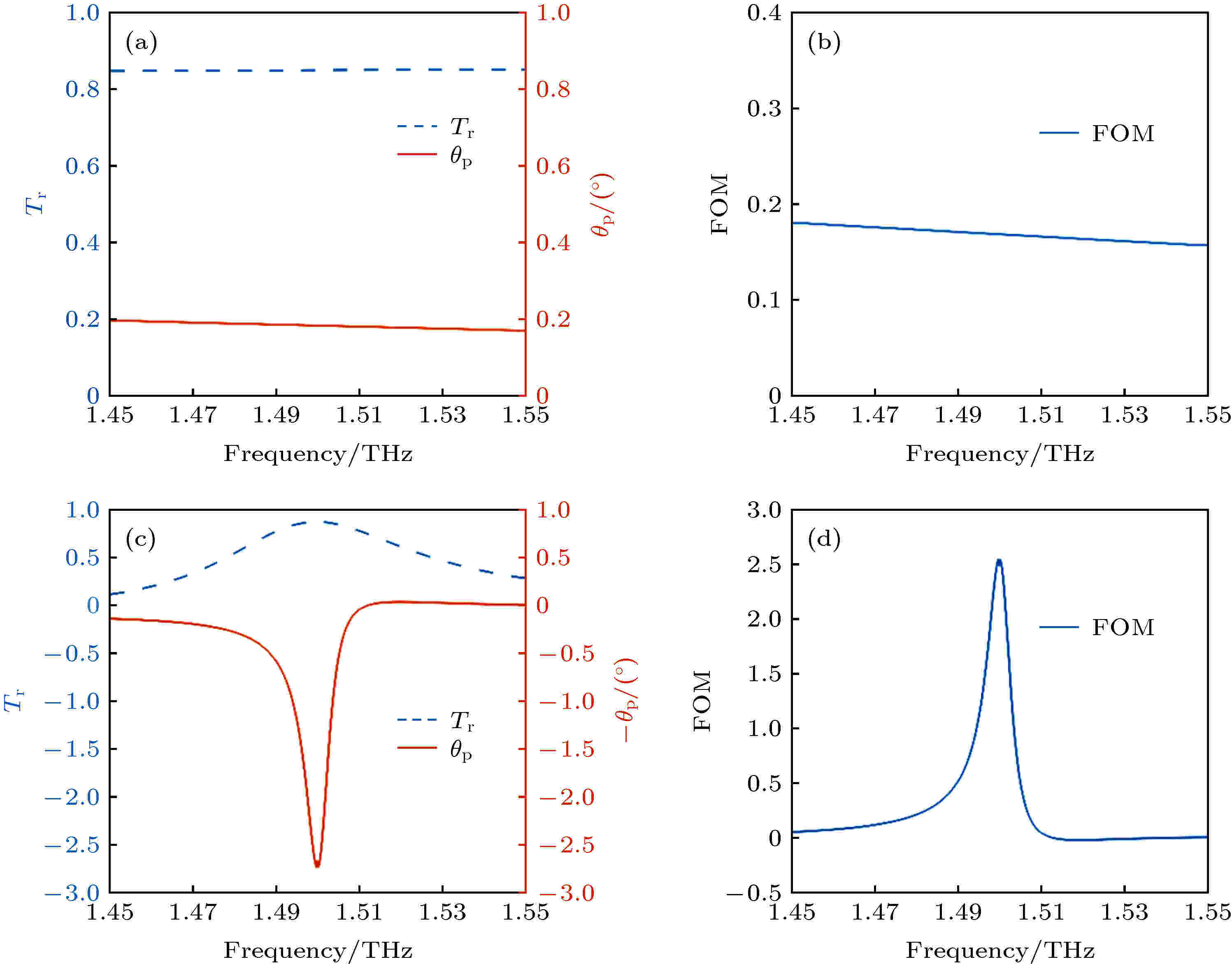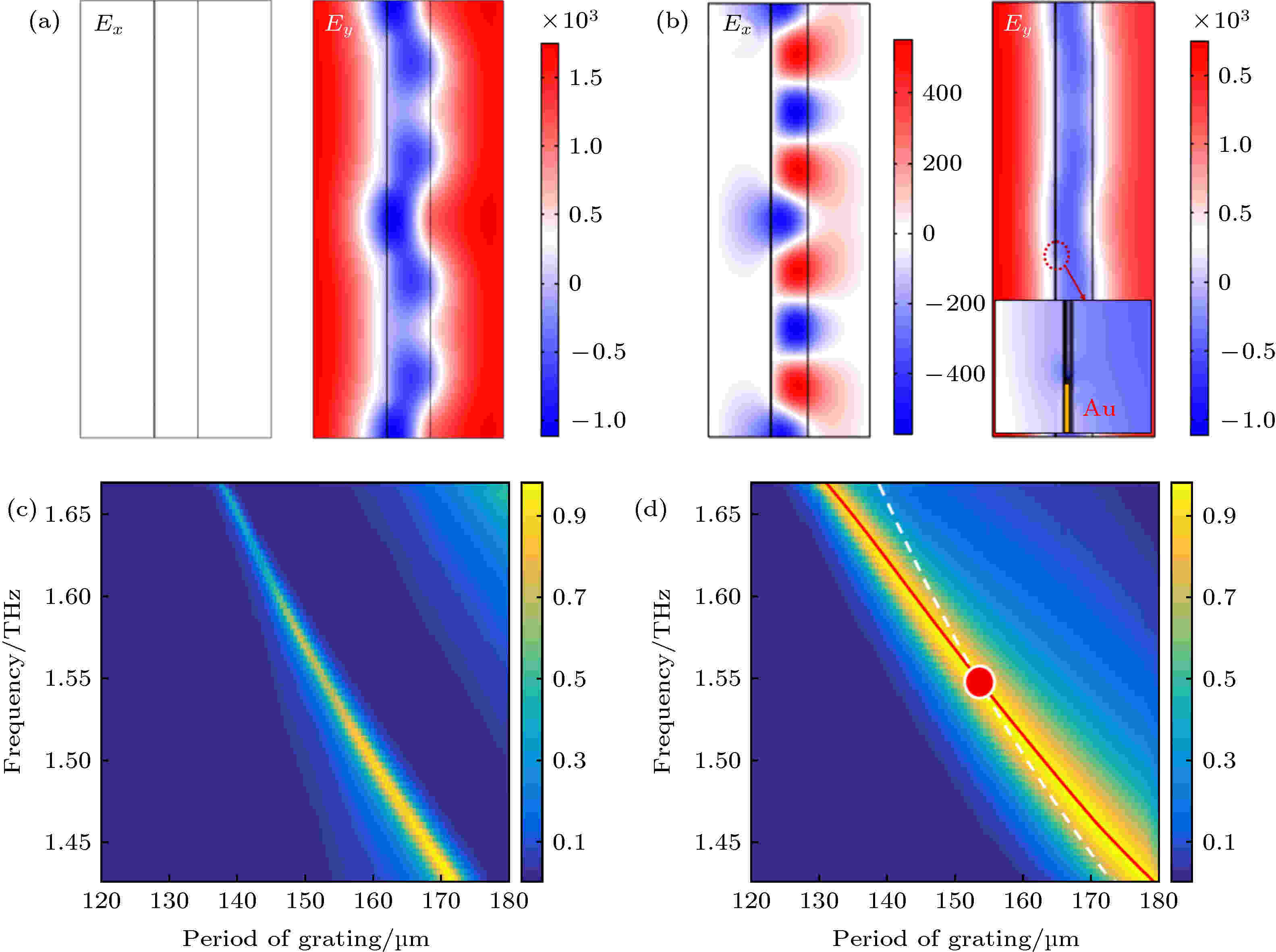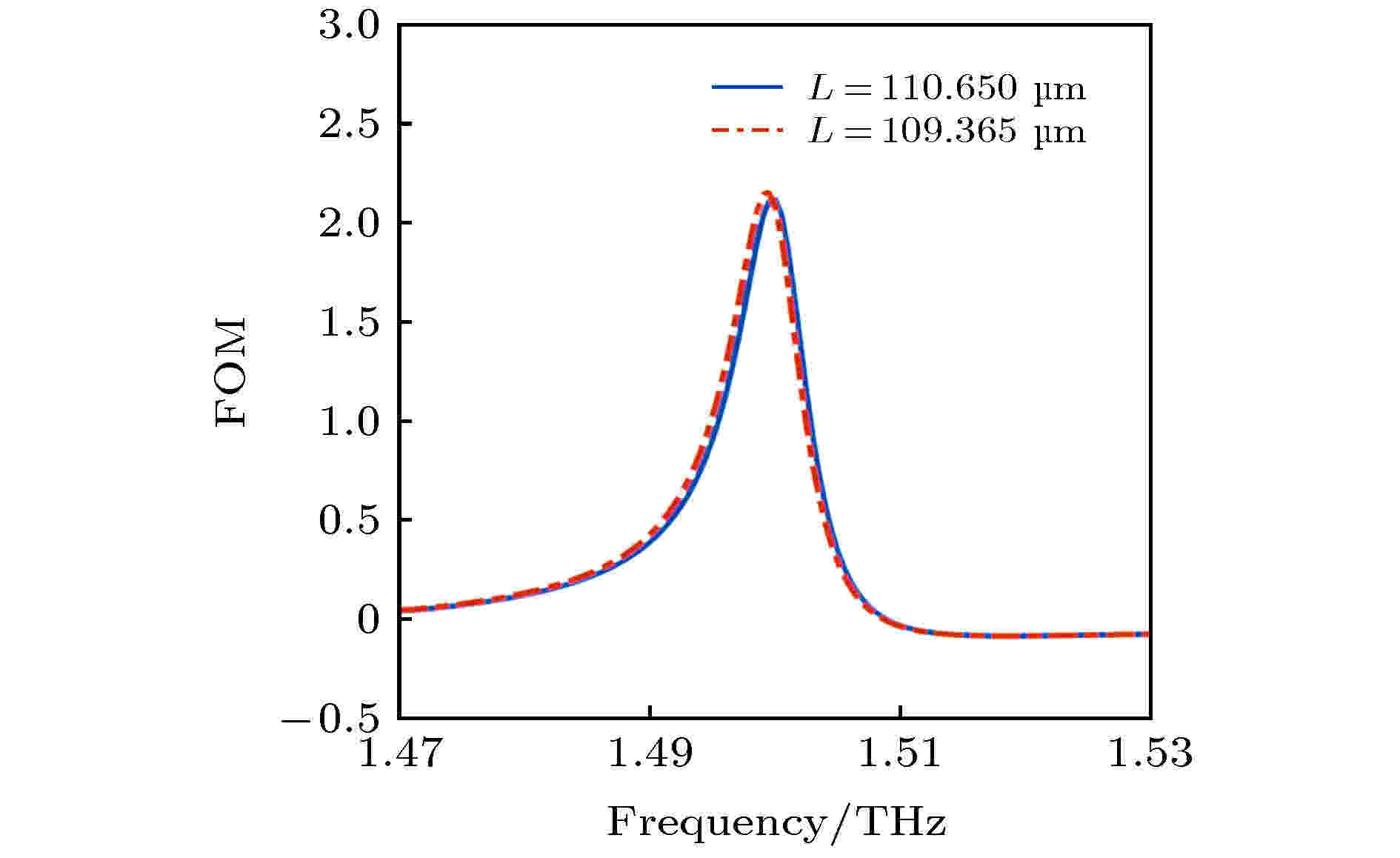全文HTML
--> --> -->近几年, 随着只有单原子厚度的二维材料的发展, 在亚波长甚至更低尺度获得法拉第效应已经成为现实. 最早是在石墨烯[3,12,13]上实现了磁光效应、后来其他的二维材料如过渡金属硫化物[2]和黑磷[14–16]等也都通过理论和实验验证了磁光效应的存在. 和石墨烯、过渡金属硫化物相比, 一方面, 黑磷面内各向异性的结构, 使其在光学方面表现出了一些特殊的光学特性. 另一方面, 黑磷有较高电荷迁移率和开关比, 而且直接带隙可以从0.3 eV拓展到2.0 eV, 填补了石墨烯和过渡金属硫化物之间的带隙空白, 拓展了二维材料应用的波段; 同时, 黑磷的带隙可以通过应力、温度、化学掺杂和电压等方法进行调制, 使基于黑磷设计的器件更加灵活可调[17–22]. 正如前面所讲, 黑磷具备磁光效应, 因此在中红外甚至太赫兹领域黑磷可以作为设计微纳尺度磁光器件的一种具有很大潜力的材料.
目前, 关于单层和多层黑磷的磁光效应的研究已经有一些报道, 2015年, Zhou 等[23]通过理论方法研究了在外部磁场作用下的黑磷的朗道能级和磁输运特性. 同年, Zhou等[14]和Jiang等[15]又分别研究了多层黑磷在外部磁场作用下的光响应和电响应特性. 2019年, You等[24]报道了单层黑磷的磁等离子体特性以及由外部磁场和各向异性晶格结构诱导的各向异性磁光响应. Li等[21]在研究中给出了单层黑磷的法拉第旋转角度和表面电导率非对角元之间σxy的关系. 当前的研究表明, 单层黑磷的法拉第旋转是有非对角元σxy引起的. 所以和石墨烯类似, 只有在回旋频率附近, 才能产生较大的旋转角度, 这限制了单层黑磷的应用范围, 因此, 设计微纳结构来增强单层黑磷的法拉第旋转是值得研究的一个重要内容. 目前, 对于石墨烯的法拉第效应增强采用的方法主要有谐振腔[25]、磁光子晶体[26]和异常透射[27]等, 而对于单层黑磷的法拉第效应增强, 除了我们课题组前面研究的通过磁光子晶体缺陷模式实现外[11], 其他的相关报道还未看到.
在本文中, 设计了一个金光栅/黑磷/硅的混合等离子体结构(grating/BP/Si, GBPS)实现了对单层黑磷的法拉第效应的增强, 通过严格耦合波(rigorous coupled wave analysis, RCWA)的方法, 研究了光栅/硅(grating/Si, GS)结构的透射谱特性, 给出了设计磁光器件的基本方法. 由于二维材料非常薄, 厚度只有原子大小尺度, 所有一般可以采用薄膜介质模型[28–30]或者表面电流模型[31,32]进行表征, 本文在进行有限元仿真的过程中, 采用了表面电流的模型对黑磷进行表征. 在此基础上对结构参数进行优化, 得到了一个性能较优的磁光器件. 当设计的器件工作频率为1.5 THz时, 磁光器件的厚度远远小于半个波长, 法拉第旋转角度能够获得14.434倍的增益, 同时透射率能保持大于85%. 在此基础上, 研究了外部磁场和黑磷载流子密度对器件特性的调谐作用, 并且讨论了类等离子模式(spoof surface plasmons, SSPs)对基底波导模式和法拉第旋转角度的影响. 本文的工作对设计亚波长尺度的磁光器件具有重要的指导意义.
 图 1 磁光器件结构图 (a) 三维结构图, 底部为硅基底, 上部为金属光栅, 中间为黑磷, 磁场垂直黑磷水平面, 入射光为线偏振光; (b) 垂直面二维图, 光栅周期L, 金属条厚度da, 宽度W, 基底厚度ds
图 1 磁光器件结构图 (a) 三维结构图, 底部为硅基底, 上部为金属光栅, 中间为黑磷, 磁场垂直黑磷水平面, 入射光为线偏振光; (b) 垂直面二维图, 光栅周期L, 金属条厚度da, 宽度W, 基底厚度dsFigure1. Schematic of the magneto-optical device: (a) 3D structure diagram. The Si layer is the substrate, the grating is in the top layer, and the black phosphorus (BP) is in the center laye; (b) 2D vertical plane diagram. The period of the grating is L, the thickness and the width of the metal are da and W, and the thickness of the substrate is ds.
单层的黑磷放置于基底的上表面, 光栅的下表面, 施加外磁场B垂直于黑磷的表面(如图1(a)所示). 由于黑磷具有各向异性特征, 所以其表面电导率张量可以用下列矩阵表示:
当一束波长为λ的光以入射角γ入射到带有衬底的金属光栅, 光栅厚度

根据光栅耦合的布拉格条件(7)式和SSPs色散关系来设计同时实现异常透射和增强法拉第旋光效应的结构. 首先, 假设衬底导模为基模, 并且引入的光栅对衬底波导的传输模式没有影响[35], 在TM偏振光垂直入射时, 可以确定期望工作频率下的法拉第旋转器衬底厚度为λ/(2nSi), 波导的等效折射率介于空气和衬底折射率之间, 由(7)式可知光栅周期L的范围为(mλ—mλ/nSi). 其次, 为了表征最优的器件性能, 此处定义了品质因数(figure of merit, FOM) FOM = (T)1/2 × θF作为优化参数的目标. 在设定的工作频率下通过严格耦合波的方法对周期(范围为mλ—mλ/nSi)和光栅占空比(占空比设置大于0.5, 扫描范围为0.5—1.0)进行扫描, 可以获得在考虑光栅对衬底影响下, 品质因数较优的光栅周期和金属宽度. 在此基础上, 再对光栅调制深度进行优化, 可以得到最优的品质因数. 最后, 考虑单层黑磷的影响. 由于黑磷是原子层厚度, 它对器件的透过率和波导模式的影响可看成是一个微扰, 通过有限元仿真软件对周期L再进行小范围的精确扫描, 即可得到该工作频率下品质因数最优的结构参数.
假设一束偏振光正入射到磁光器件表面, 偏振方向垂直光栅方向(TM波), 如图1所示, 则当这束偏振光透射过器件以后, 平行入射场方向的透射系数可以表示为


 图 2 单层黑磷和磁光器件透射谱、法拉第旋转角度和品质因数谱 (a) 虚线为单层黑磷的透射率频谱图, 实线为法拉第旋转角度频谱图; (b) 单层黑磷的品质因数频谱图; (c) GBPS结构的透射率频谱图和法拉第旋转角度频谱图; (d) GBPS结构的品质因数频谱图
图 2 单层黑磷和磁光器件透射谱、法拉第旋转角度和品质因数谱 (a) 虚线为单层黑磷的透射率频谱图, 实线为法拉第旋转角度频谱图; (b) 单层黑磷的品质因数频谱图; (c) GBPS结构的透射率频谱图和法拉第旋转角度频谱图; (d) GBPS结构的品质因数频谱图Figure2. The transmittance, Faraday rotation angle and the figure of merit (FOM) of the monolayer BP and magneto-optical device verse the frequency: (a) The dotted line is the transmittance of the monolayer BP, and the solid line is the Faraday rotation angle of the monolayer BP; (b) the FOM of the monolayer BP; (c) the dotted line is the transmittance of the magneto-optical device with GBPS structure, and the solid line is the Faraday rotation angle of the magneto-optical device with GBPS structure; (d) the FOM of the magneto-optical device with GBPS structure.
为了解释异常透射增强黑磷法拉第旋转角度的物理机制, 首先通过Comsol仿真了在1.5 THz频率点的电场分布图, 仿真使用的结构参数和计算图2(c)使用的一致. 为了说明法拉第旋转角度产生的原因, 分别给出了TM模式下(Hx垂直yz面), GS结构和GBPS结构的电场沿x方向和y方向的分布. 如图3(a)所示, 当没有黑磷存在时, Ex分量为零, 只有Ey分量存在. 而加入黑磷后, 如图3(b)所示, GBPS下的电场不仅存在Ey分量, 同时Ex也存在, 这说明加入黑磷后, 使电磁场发生旋转, 从而产生了x分量的电场. 由此可以说明黑磷是产生法拉第旋转的关键.
 图 3 磁光器件电场分布图和TE/TM透射谱 (a) GS结构, 1.5 THz时TM模式下的Ex, Ey分布图; (b) GBPS结构, 1.5 THz时TM模式下的的Ex, Ey分布图, Ey分布图中放大部分为金属光栅端子上的场分布; (c) TE模式下透射率随频率和光栅周期的变化图; (d) TM模式下透射率随频率和光栅周期的变化图
图 3 磁光器件电场分布图和TE/TM透射谱 (a) GS结构, 1.5 THz时TM模式下的Ex, Ey分布图; (b) GBPS结构, 1.5 THz时TM模式下的的Ex, Ey分布图, Ey分布图中放大部分为金属光栅端子上的场分布; (c) TE模式下透射率随频率和光栅周期的变化图; (d) TM模式下透射率随频率和光栅周期的变化图Figure3. The electric field distribution and the TE/TM transmittance spectrum of the magneto-optical device: (a) The Ex and Ey of the device without the monolayer BP in TM mode at 1.5 THz; (b) the Ex and Ey of the device with GBPS structure in TM mode at 1.5 THz, and the electric field distribution on the metal grating terminal is shown in the enlarged part of Ey; (c) variations of transmittance with frequency and grating period in TE mode; (d) variations of transmittance with frequency and grating period in TM mode.
为了进一步说明法拉第磁光效应增强的工作机制, 通过RCWA方法计算了在不同的光栅周期下, TM和TE模式下的反射谱, 以此说明其模式的变化. 除光栅周期L外, 其他的结构参数和上节内容使用的一致. 如图3(c)所示为TE模式下的透射谱, 随着光栅周期L增加, 本征模式发生了红移. 同时因为TE模式下无法激发SSPs模式, 所以此时只存基底硅层中的TE本征波导模式. 当入射波为TM时, 图3(d)为TM模式下的透射谱, 同样随着光栅周期L增加, 模式发生红移, 符合(7)式中L和λ的相对关系. 在这个模式下的电场分布如图3(b)所示, 其中电场分量Ex被局域在基底的硅波导中, 可以从场分布看到出现的为基模, 符合设计结构参数, 因此TM的本征波导模式存在. 由于TM入射激发了SSPs模式, 当SSPs模式耦合到TM的本征波导模式后会对TM的色散产生影响, 出现波导模式和SSPs模式混合的新的WSPM模式. 研究表明, 如果衬底只存在TE本征波导模式和TM本征波导模式, 那么TM和TE模式的色散曲线是不会相交的[27,36], 所以在激发了SSPs模式而改变TM的色散后, 才出现TE和WSPM模式的色散曲线交叉的情况. 如图3(d)上的实线和虚线所示, 当不断增加光栅周期的时候, 也就是通过SSPs改变TM模式下的色散的时候, TE和WSPM模式的传播常数出现的交点, 如图3(d)中实心圆所示位置, 而且还存在一些重合的地方. 这时TE和WSPM模式满足匹配条件, 耦合效率较高. 同时如图2(b)中电场分量Ey的放大图所示, 在金属光栅的端点上, 出现了极强的电场局域, 该电场在SSPs的模式波长下与黑磷发生了强烈作用, TE和TM的转换效率达到最高值, 磁光法拉第效应达到最强. 因此, 法拉第磁光效应的增强是由于TE和WSPM模式发生耦合产生的结果, 同时高透射率是由于在模式匹配条件下异常透射引起的.
法拉第磁光效应是由于外部磁场激发霍尔表面电流而产生的. 为了揭示外部磁场对法拉第磁光效应的影响, 计算了不同外部磁场下的法拉第旋转角度和品质因数. 如图4(a)所示, 当外部磁场从3 T逐渐增加到9 T的时候, 法拉第旋转角度也随之逐渐增加, 分别为1.656°, 2.743°, 3.803°和4.829°, 对应的工作频率点保持不变. 法拉第旋转角度随外部磁场增加的幅值分别为1.087°/T, 1.06°/T 和1.026°/T, 基本呈现线性关系. 因此可以通过调制外部磁场来对旋转角度大小进行控制. 图4(b)是磁光器件品质因数随外部磁场的变化频谱图. 从图4(b)可以看到, 当外磁场逐渐增大时, 品质因数也同时和法拉第旋转角度一样成线性增加, 这反映在外部磁场变化的时候, 透射率基本保持不变. 产生透射率基本不变, 而法拉第旋转角度成线性变化的现象是因为ξ远远大于ω和ωc, 在这个情况下可以从(4)式看到电导率的非对角元σxy(σyx)和ωc成正比关系, 而ωc和外部磁场B成正比关系, 法拉第旋转角度和σxy成正比关系, 所以法拉第旋转角度和外部磁场也成正比关系. 另外, 单层黑磷对透射率的影响主要取决于电导率的对角元张量σxx和σyy, 而从(3)式看, 在ξ远远大于ω和ωc的情况下, 外部磁场B对σxx和σyy的影响几乎可以忽略, 所以, 在外部磁场变化的时候, 透射率基本保持变. 这个结论与我们前面的研究结论一致[11], 通过改变磁场对法拉第旋转角度进行调节是一个有效可行的方法.
 图 4 外部磁场分别为3, 5, 7和9 T下的磁光器件响应图 (a) GBPS结构的透射率频谱图; (b) GBPS结构法拉第旋转角度频谱图
图 4 外部磁场分别为3, 5, 7和9 T下的磁光器件响应图 (a) GBPS结构的透射率频谱图; (b) GBPS结构法拉第旋转角度频谱图Figure4. The magneto-optical response diagrams of the device when the external magnetic fields are set as 3, 5, 7 and 9 T: (a) Transmission and (b) faraday rotation angle of the device with GBPS structure.
因为黑磷的载流子密度可以通过费米电压、温度和黑磷层数等手段进行调控, 所以在前面研究基础上, 进一步研究了单层黑磷载流子密度对法拉第磁光器件的影响. 在磁光器件其他参数与图2(c)保持不变的情况下, 分别计算了载流子密度为0.5n0, 1.0n0, 1.5n0和2.0n0情况下对应的法拉第旋转角度和透射率. 如图5(a)所示, 当载流子密度增加后, 工作频率点分别为1.500, 1.501, 1.503和1.504 THz, 法拉第旋转角度频谱发生了轻微蓝移, 法拉第旋转角度有所增加, 但是却没有如(4)式所示成比例增加, 原因是此处法拉第磁光器件的结构参数是在ns = 0.5n0情况下优化得到的, 当黑磷载流子密度发生变化后, 结构表面的表面电流特性发生了变化, 对磁光器件的共振模式产生了微扰, 破坏TE模式和TM等离子混合模式的耦合, 从而削弱了磁光效应的增强. 图5(b)的品质因数的工作频率点偏移和法拉第角度保持一致, 但是品质因数在法拉第旋转角度增大的情况下却有所下降, 这说明当载流子浓度增大后, 透射率下降较大, 造成这个原因是因为当载流子浓度增大后对角元σxx和σyy也随之增大, 造成吸收增强[37], 所以造成品质因数下降. 结合外部磁场对法拉第磁光器件的影响, 可以通过外部磁场和载流子浓度进行一起调控, 达到工作频率点和旋转角度的动态调谐.
 图 5 不同载流子浓度下的磁光器件响应图 (a) GBPS结构的透射率频谱; (b) GBPS结构的法拉第旋转角度频谱. 黑磷载流子浓度度分别为0.5n0, 1.0n0, 1.5 n0, 2.0 n0 (n0 = 1 × 1013 cm–2)
图 5 不同载流子浓度下的磁光器件响应图 (a) GBPS结构的透射率频谱; (b) GBPS结构的法拉第旋转角度频谱. 黑磷载流子浓度度分别为0.5n0, 1.0n0, 1.5 n0, 2.0 n0 (n0 = 1 × 1013 cm–2)Figure5. Magneto-optical response diagrams of the device with different carrier density of BP: (a) Transmission and (b) faraday rotation angle of the device with GBPS structure. The carrier density of BP are set as 0.5n0, 1.0n0, 1.5 n0, 2.0 n0 (n0 = 1 × 1013 cm–2).
最后, 从法拉第磁光器件的工作物理机制, 我们知道TM入射时候的SSPs对增强器件法拉第旋转起到了关键作用. 一维半无限厚的金属光栅的SSPs色散关系如下式所示[38]:
| No. | f/THz | L/μm | W/μm | ds/μm | T/% | θp/(°) |
| 1 | 1.40 | 170.580 | 118.150 | 31.377 | 84.354 | 4.3845 |
| 2 | 1.45 | 164.650 | 113.160 | 30.750 | 85.256 | 3.4711 |
| 3 | 1.50 | 159.000 | 109.365 | 29.285 | 86.968 | 2.7426 |
| 4 | 1.55 | 153.500 | 105.915 | 28.414 | 87.123 | 2.1730 |
| 5 | 1.60 | 148.800 | 102.810 | 27.455 | 86.679 | 2.1443 |
表1磁光器件不同结构参数下的法拉第旋转角度和透射率
Table1.Faraday rotation and transmittance of the MO device with different structure parameters.
一方面, 从表1可以看到, 随着基底厚度不断减小, 工作频率不断增加, 也就是基底等效波长和传播常数不断变小, 符合TE本征波导模式的变化规律. 同时, 满足TE本征波导模式和WSPM模式匹配条件的光栅周期L随着工作频率增加而减少, 光栅周期L的这一变化规律符合SSPs色散方程. 另一方面, 表1中的数据可以说明, 磁光器件通过合适的结构参数设计, 在1.4—1.6 THz范围内, 可以在保持透射率大于84%的情况下, 实现单层黑磷法拉第角度大于2.1443°, 增益大于10倍以上. 因此, 通过调谐SSPs模式可以改变WSPM模式的传播常数, 使之和TE本征波导模式的传播常数匹配, 满足实现波矢匹配的条件, 从而达到在保持高透射率情况下增强法拉第磁光效应. 按照此方法, 也可以推广到其他波段的磁光器件的设计.
最后, 在设计器件的时候还需要注意一个问题, 单层黑磷在空气中的稳定性较差, 容易氧化. 为了隔离黑磷和空气的相互作用, 可以在金属光栅之间填充二氧化硅(

 图 6 光栅中间填充二氧化硅后的磁光器件品质因数, 实线表示光栅宽度为109.365 μm, 点划线表示光栅宽度为110.650 μm
图 6 光栅中间填充二氧化硅后的磁光器件品质因数, 实线表示光栅宽度为109.365 μm, 点划线表示光栅宽度为110.650 μmFigure6. The FOM of the MO device when the grating is filled with SiO2. The solid line indicates that the grating width is 109.365 μm, and the dashed line indicates that the grating width is 110.650 μm.
